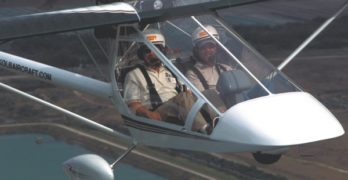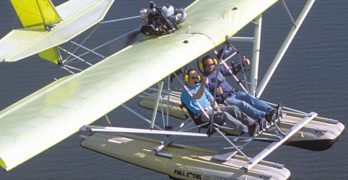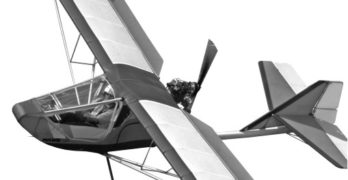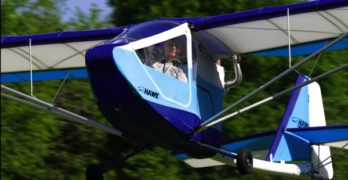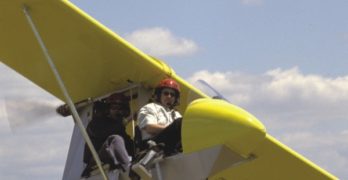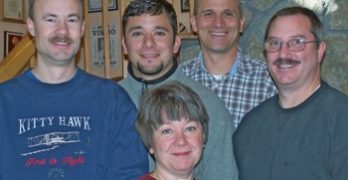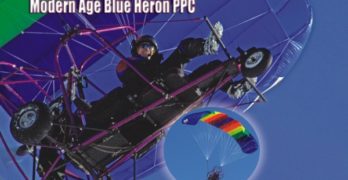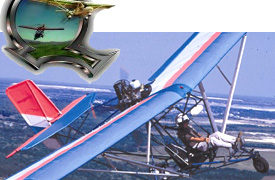“Xtra” - a word to make a computer spell-checker stumble – is an appropriate name for this month’s pilot’s report, The New Kolb Aircraft Company Mark III Xtra side-by-side 2-seater. It literally offers extra in several ways pilots will like.
The venerable Mark III has been through a series of changes since original company founder Homer Kolb first brought out a 2-seater called the TwinStar. The latest change does a lot to alter the appearance of the older design.
Kolb designs have narrow noses like a lot of other designs. The new Xtra presents a clean edge cutting through the air, but it now has a wider look – at least from head-on – that imparts a new feel to the occupants. Some will say the “Xtra” comes from “Extra-Wide.” With its bulging doors, the new cabin is 45 inches wide (42.5 at the hips).
Although the design will look bigger and heavier to some, the new shape is one you’ll come to like… if you have a seat.
Search Results for : Part 103
Not finding exactly what you expected? Try our advanced search option.
Select a manufacturer to go straight to all our content about that manufacturer.
Select an aircraft model to go straight to all our content about that model.
Float-Flying the M-Squared Sprint 1000
“Air in your hair!
Space on your face! A breeze on your knees!” A former colleague of mine used to repeat this short mantra to illustrate the joy of open-cockpit flying. It was catchy and engaging and his customers liked it.
With 15 Light-Sport Aircraft now possessing their FAA Special Light-Sport Aircraft (SLSA) airworthiness certificates, not a single one is open cockpit, though the IndUS Thorpedo, Legend Cub, and Tecnam Sierra can enjoy partially open cockpits.
Special Light-Sport Aircraft will eventually add more of this genre of light aircraft but one of the beauties of FAA’s new regulation is that it does not eliminate two previous categories: Amateur-built 51% kits or Part 103-compliant ultralights.
With 21¼4 years left before operators of 2-seat 496-pound empty weight ultralight exempt trainers must register in FAA’s new Light-Sport Aircraft category, and with 41¼4 years left while these machines can be used for compensated training flights, the segment still has lots of life remaining.
CGS Aviation Makes Hawk
Remember why we fly ultralights? Few general aviation airplanes are flown below 1,500 feet above the ground. More rare is flight at 500 feet or 50 feet. Neither do you tend to fly most light-sport aircraft (LSAs) at these denser altitudes. Most flights in general aviation or LSA planes start out climbing high as quickly as possible. You switch on the autopilot as soon as possible and fiddle with the throttle, prop and mixture controls to squeeze all the fuel economy you can while flying as fast as the machine will manage in the straightest possible line all the way to your destination.
That’s fine for general aviation or LSA flying, and it’s enjoyable in a different way. But it isn’t ultralight flying.
What about just “boating around” the sky at your leisure, turning every few minutes to see the sights only possible from an ultralight aircraft. Your eye catches an alligator off to one side and you bank quickly to check it out.
CGS Pulls Out the Stops
… to keep the Hawk Ultra Light
Genuine ultralights still
have a place. These
aircraft|excuse me,
ultralight vehicles,
the least-FAA-regulated
flying machines,
will not be sent to aircraft boneyards
despite what some light-sport aircraft
skeptics may think. The Hawk Ultra
is proof positive CGS Aviation loves
ultralights and wants you to have fun
in the air.
No matter the pros and cons of
the sport pilot/light-sport aircraft (SP/
LSA) rule, operating a Part 103 ultralight
remains simpler than earning a
sport pilot certificate and buying an
LSA. No certificate, no medical, and
no registration is needed (though, it is
recommended that folks register with
one of the three associations supporting
ultralights-EAA, the United States
Ultralight Association (USUA), and Aero
Sports Connection (ASC). Additionally,
an ultralight can be fully factory built
without FAA inspections. The list of 103
privileges goes on, and the Hawk Ultra
qualifies for all of them.
One-Oh-Three Interest Soars
I don’t know about the “build it
and they will come” premise when
it comes to baseball fields, but I fervently
believe that if enough customers
want a product, someone will supply
it.
The Lil’ Breezy B-Model
Open-Cockpit 2-seater
ust when you felt as though Light-Sport Aircraft (LSA) was the only segment of aviation getting any press, along comes a flying machine that harks back to the early days of ultralighting but with a distinctive fuselage construction and composite wings.
Just when it seemed like every new LSA had to be enclosed, four-stroke-powered, fast, and have leather seats, along comes a new open-cockpit, mile-a-minute airplane that can easily carry two people on the power of a 50-hp Rotax 503. The leather is on your flight jacket.
The Lil’ Breezy B can weigh 350 pounds empty, fly at 60 mph, and sell for $12,500 (for all parts plus engine/prop but not your assembly labor). In my experience that sounds like an ultralight. Born in the new millennium, the Lil’ Breezy B is a modern ultralight.
Before we go fly, let’s examine the machine and talk to its developer, Jack Harper.
What To Do?
Some buyers are unsure how to weigh the decision between ultralight and the new light-sport aircraft. While Heldeberg Designs works on their statement of compliance to new ASTM consensus design standards, here’s some advice to Blue Heron owners from Heldeberg Designs:
“Single-seat, FAA Part 103-compliant aircraft (e.g., the Spirit 103) will have to do nothing. Part 103 will continue on in its current form.
“Older 2-seat ultralights will have to transition from the current exemption-based coverage granted by EAA, ASC, and USUA, to Light- Sport [Aircraft]. These aircraft will have to be inspected in order to receive an N-number as an Experimental Light-Sport Aircraft (ELSA). This will apply to all 2-place powered parachutes that were purchased before the new rule became effective, and provides for a 2-year transition period. This process will require owners to register their aircraft with FAA, and then have them inspected by an LSA Designated Airworthiness Representative (DAR) in order to be qualified as an ELSA aircraft.
Modern Age Blue Heron PPC
Here we are
in the spring of 2006 wondering about the future of ultralights in an age seemingly gone crazy about Sport Pilot/Light-Sport Aircraft (SP/LSA). For powered parachute manufacturer Heldeberg Designs, the answer is easy. They’ve been preparing for the LSA program for a long time. How will they fare?
Today, we have a great divide* between ultralight pilots on one side and LSA enthusiasts on the other. The ultralight pilots see rather modest benefit to becoming Sport Pilots flying ultralights converted to Experimental Light-Sport Aircraft (ELSA). One major downside is that most such aircraft will have to settle a sales tax bill (states become aware of the aircraft when owners obtain their N-numbers). Other limitations include not flying over 10,000 feet or being required to perform an annual condition inspection. And this is by no means a complete gripes list.
The LSA contingent responds, “That ship has sailed. SP/LSA is here.
Beaver RX-550
Perhaps the most famous ultralight to come out of Canada is the Beaver. With a reported 2,200 units flying since the early 1980s, this is one of the most successful light aircraft ever. However, due to missteps by companies that previously manufactured the brand, this popular ultralight was nearly lost from the ultralight aviation landscape. Were it not for the Aircraft Sales and Parts (ASAP) company and the Holomis family, you might not have this choice today.
Originally the Beaver RX-550 came from a company called Spectrum Aircraft. A company reorganization left the ultralight in the hands of a company named Beaver RX Enterprises. Both these business names disappeared and today the ASAP brand carries the Beaver into the sky.
In 1993, a couple years after our last report on the Beaver1, the old company closed its doors and effectively stranded thousands of Beaver ultralight owners and all the dealerships that sold them.
Clicking Down to a Deadline for Ultralight Pilots
So, you’re an ultralight pilot with many hours flying one of the great light airplanes that enjoyed the limelight long before Light-Sport Aircraft. Then FAA goes and creates a new class of pilot. Now, despite your pilot credential from USUA, ASC, or EAA, you have to go get a new one. Earning it involves a written test plus a flight check with oral exam…all of which you’ve already taken. “What sense does that make,” you ask? Point taken, but that flight has left the ground. You have to do it and you ought to do it soon. Why? Because if you act before January 31, 2007, you can at least get credit for all that time you’ve logged. What’s worse than having to pay to take tests for stuff you already know? How about having to go fly with an instructor to acquire the 20 hours it takes to qualify for a Sport Pilot certificate?
Ultralight Trainers for the Future
A more real concern about the
future of ultralights revolves around
the availability of ultralight trainers
to prepare new pilots for flight in
Part 103 ultralights like the Ultra.
Wonderful as many of the new LSA
may be, most are inappropriate aircraft
to train you for flight in a Hawk
Ultra|or almost any other genuine
103 machine. The question ponders
the likelihood of companies building
ultralight trainer-type aircraft as
fully built, fully certificated special
light-sport aircraft (S-LSA), the minimum
standard to which all trainers
must be built once the two-place
exemptions expire on January 31,
2008. (Note: Two-place trainers that
have transitioned to experimental
light-sport aircraft status, E-LSA, can
still be used for training purposes by
the original owner/instructor until
January 31, 2010.)
Even if ultralight manufacturers
do choose to build an S-LSA trainer,
will it be affordable? Again, consumer
demand will play a role in
this decision; CGS is evaluating the
market and may create an S-LSA
ultralight trainer.
- « Previous Page
- 1
- …
- 31
- 32
- 33
- 34
- 35
- …
- 53
- Next Page »


